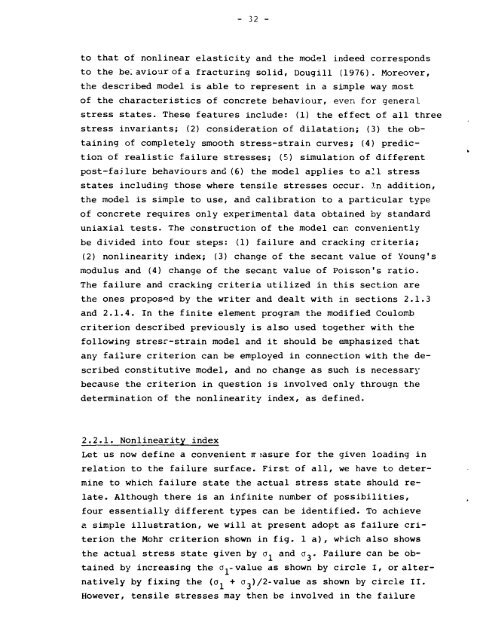Nonlinear Finite Element Analysis of Concrete Structures
Nonlinear Finite Element Analysis of Concrete Structures
Nonlinear Finite Element Analysis of Concrete Structures
Create successful ePaper yourself
Turn your PDF publications into a flip-book with our unique Google optimized e-Paper software.
- 32 -<br />
to that <strong>of</strong> nonlinear elasticity and the model indeed corresponds<br />
to the bei aviour <strong>of</strong> a fracturing solid, Dougill (1976). Moreover,<br />
the described model is able to represent in a simple way most<br />
<strong>of</strong> the characteristics <strong>of</strong> concrete behaviour, even for general<br />
stress states. These features include: (1) the effect <strong>of</strong> all three<br />
stress invariants; (2) consideration <strong>of</strong> dilatation; (3) the obtaining<br />
<strong>of</strong> completely smooth stress-strain curves; (4) prediction<br />
<strong>of</strong> realistic failure stresses; (5) simulation <strong>of</strong> different<br />
post-fajlure behaviours and (6) the model applies to all stress<br />
states including those where tensile stresses occur. In addition,<br />
the model is simple to use, and calibration to a particular type<br />
<strong>of</strong> concrete requires only experimental data obtained by standard<br />
uniaxial tests. The construction <strong>of</strong> the model can conveniently<br />
be divided into four steps: (1) failure and cracking criteria;<br />
(2) nonlinearity index; (3) change <strong>of</strong> the secant value <strong>of</strong> Young's<br />
modulus and (4) change <strong>of</strong> the secant value <strong>of</strong> Poisson's ratio.<br />
The failure and cracking criteria utilized in this section are<br />
the ones proposed by the writer and dealt with in sections 2.1.3<br />
and 2.1.4. In the finite element program the modified Coulomb<br />
criterion described previously is also used together with the<br />
following stresr-strain model and it should be emphasized that<br />
any failure criterion can be employed in connection with the described<br />
constitutive model, and no change as such is necessary<br />
because the criterion in question i s involved only througn the<br />
determination <strong>of</strong> the nonlinearity index, as defined.<br />
2.2.1. <strong>Nonlinear</strong>ity index<br />
Let us now define a convenient ir ;asure for the given loading in<br />
relation to the failure surface. First <strong>of</strong> all, we have to determine<br />
to which failure state the actual stress state should relate.<br />
Although there is an infinite number <strong>of</strong> possibilities,<br />
four essentially different types can be identified. To achieve<br />
a simple illustration, we will at present adopt as failure criterion<br />
the Mohr criterion shown in fig. 1 a), which also shows<br />
the actual stress state given by a, and o~. Failure can be obtained<br />
by increasing the a,-value as shown by circle I, or alternatively<br />
by fixing the (o, + o,)/2-value as shown by circle II.<br />
However, tensile stresses may then be involved in the failure
















